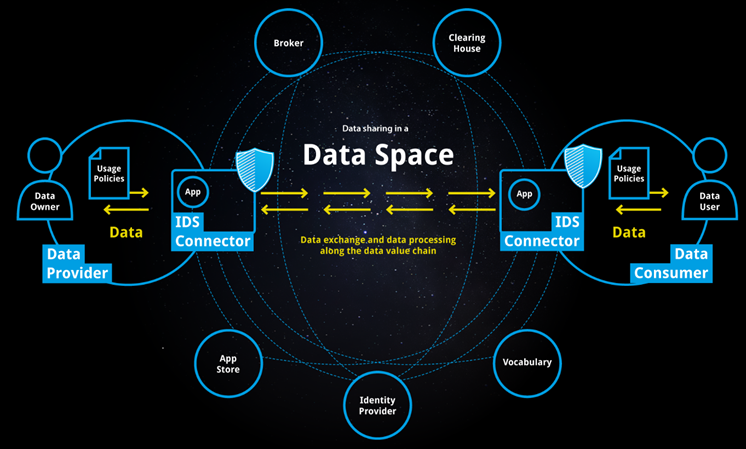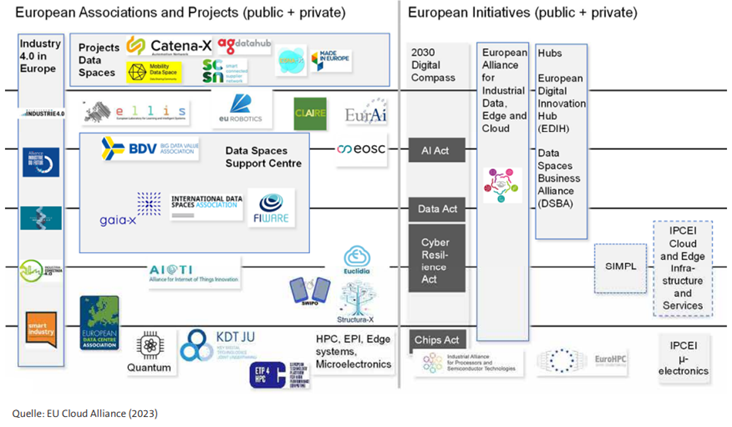Industrial Data Spaces
Connections to other concepts
- Reference architecture model IDS-RAM is based on RAMI 4.0
- IDS-RAM (reference architecture model for international data rooms)
- GAIA-X RAM describes the concepts required to build the GAIA-X data and infrastructure ecosystem with the aim of creating a federated open data infrastructure
- OPC UA with Companion Specifications is a basis of sovereign digital ecosystems. This achieves interoperability through system and platform independence, standardized use of different types of communication and standardized content.
- AAS with SMT is a digital representation of an asset in the context of Industrie 4.0 and provides data about an asset (e.g. product life cycle data). In combination with the asset, it is referred to as an Industry 4.0 component and serves as an enabler for mapping an entire value chain.
Short description
- The Data Space Support Center (DSSC) defines that a data space is a distributed system defined by a governance framework. It enables secure and trustworthy data transactions between participants supporting trust and data sovereignty. It is implemented by one or more infrastructures and enables one or more use cases.
- Fraunhofer characterizes Industrial data spaces by the following key features
- data sovereignty - the data owner determines terms of use of their data and under which conditions transactions of their data may take place
- security of data transactions - Guarantee of data security across entire data supply chains via a protection level concept
- Decentralization and federal architecture - no central instance for data storage or governance tasks, but manifestation as the totality of all endpoints with Industrial Data Space Connectors
- Governance and common rules - Joint development of rights and obligations for data management, derived from user requirements
- Network of platforms and services - Connection between data provider (companies, machines, persons, data platforms or marketplaces) and data user
- Scaling and network effects - the more participants in the data space, the more attractive it is for data providers, users and data service providers (infrastructural character)
- According to Fraunhofer, there are designated roles in the Data Space and each participant can perform one or more roles and can delegate individual activities to third parties:
- Data provider: Owner of data sources that he can make available to other participants in the Industrial Data Space while maintaining his sovereignty over them.
- Data user: obtains data from other participants.
- Broker: Mediates data offers and data requirements between data providers and data users.
- AppStore operator: Software and data services developed by different participants can be made available in the app store.
- Certification body: ensures that the software components of the Industrial Data Space fulfill the jointly defined user requirements and comply with norms and standards.

Figure 1 Overview of functionality of a Data Space (Source: https://internationaldataspaces.org/why/data-spaces/)
Facts and figures
- The Fraunhofer-Gesellschaft has produced a white paper on Industrial Data Spaces to provide an overview of their objectives and architecture and to present selected application scenarios and the Industrial Data Space e.V.
- Influence of European legislation as part of the European data strategy: Data Act, Data Governance Act, Digital Services Act, Cyber Resiliency Act and NIS-2
- Overview of the various European initiatives on digital sovereignty

Figure 2 European initiatives on digital sovereignty (Source: d7ddb31f-7d90-1e9e-d6ae-ed05246dee63 (vdma.org))
Stakeholders
- VDMA (German Engineering Federation)
- Fraunhofer-Gesellschaft
- DSSC (Data Space Support Center)
- Industry 4.0 platform
- IDTA (Industrial Digital Twin Association)
- IDS (International Data Space e.V.)
- European Commission
- National ministries (EU)
- IDSA (International Data Spaces Association)
- GAIA-X AISBL
- Catena-X Automotive Network e.V.
Use cases
- Industry-related data room initiatives
- Manufacturing-X (Plattform Industrie 4.0 - Manufacturing-X Initiative (plattform-i40.de))
- SM4RTENANCE (Home - SM4RTENANCE)
- Catena-X Automotive Network (Catena-X Automotive Network | Catena-X)
- Mobility Data Space (Mobility Data Space - Mobility Data Space - The Data Sharing Community (mobility-dataspace.eu))
- Silicon Economy (Homepage - Silicon Economy (silicon-economy.com))
- Smart Connected Supplier Network (SCSN) (Home (smart-connected.nl))
- FabOS (FabOS (fab-os.org))
- InterOpera (Homepage - InterOpera)
- EuProGigant (EuProGigant The lead project for GAIA-X in the production environment)
- SmartAgriHubs (Homepage | SmartAgriHubs)
Industry sectors
- Mechanical engineering
- Chemical and pharmaceutical industry
- Food industry
- Automotive industry
- Electrical industry
- Other industries
Sources
- Industrial Data Space - Digital sovereignty over data (White Paper) (fraunhofer.de)
- d7ddb31f-7d90-1e9e-d6ae-ed05246dee63 (vdma.org)
- Starter Kit for Data Space Designers | Version 1.0 | March 2023 - Starter Kit - Data Spaces Support Center (dssc.eu)
- 2. core concepts - Glossary - Data Spaces Support Center (dssc.eu)
- Data Spaces - International Data Spaces